Making soap
This entry has nothing to do with computers or technology, but anyway, it has been a nice experiment I will almost certainly repeat, so I want to leave an entry.
Sometime ago, we visited a friend of my now wife in Paris. She had made her own soap, and that was something I had been wanting to try for a while. She made a nice, olive oil based soap, but I wanted to try with used oil, and see if I could get something useful out of it.
There is plenty of information around, so I am not going to go into the details of saponification or anything. This is only about my experience.
It is worth noting, though, that different oils have different saponification values (how much lye per gram of fat). So you need either to dig for those values and make your own calculations, or find a calculator that does this for you. Paranoid as I am, I used two to make sure I had the right values: Mendrulandia (in Spanish), and Aroma Zone (in French). SoapCalc (in English) seems interesting too, but I haven’t tried it.
Back to the story: I had 350 grams of used sunflower oil (Used for fries, not fish, of course, so not smelly). Using the first calculator, I saw the quality of the soap made just with pure sunflower oil would be so-so. It would have too much iodine, making a soft bar of soap with tendency to get rancid. See? These calculators are indeed useful.
So I decided to compensate with other oils: olive and coconut. Of course, this kind of spoils the point of using only used oil, but anyway. I played with the calculator until I found an acceptable compromise of properties.
I ended with 350 grams of sunflower oil, 200 of olive, and 200 of coconut.
I went for an excess of fat of 5%, which gives 105 grams of caustic soda and 257 grams of water. I run this numbers in both calculators to make sure I wasn’t screwing anything related to the soda and the numbers were right, and more or less they matched. Of course, the saponification values on both calculators differ a bit, so the result won’t be 100% the same.
By the way, the caustic soda was kind of hard to find, but at the end I managed. Beware, “Cristaux de soude” != “Soude caustique”. I almost made that error.
So off I went putting everything in place.
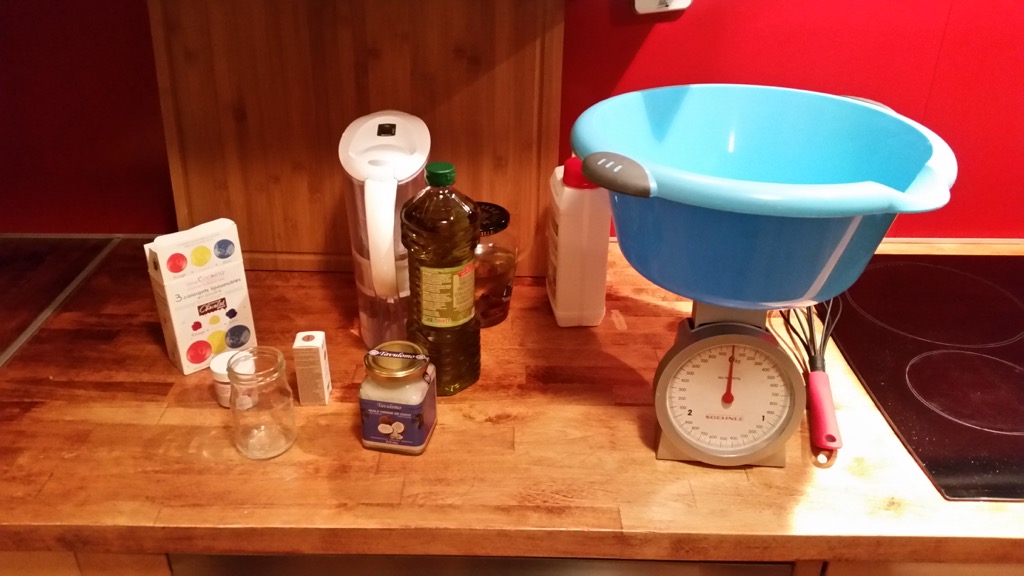 Not in the picture: long gloves, glasses and apron. No kidding with the soda.
Not in the picture: long gloves, glasses and apron. No kidding with the soda.
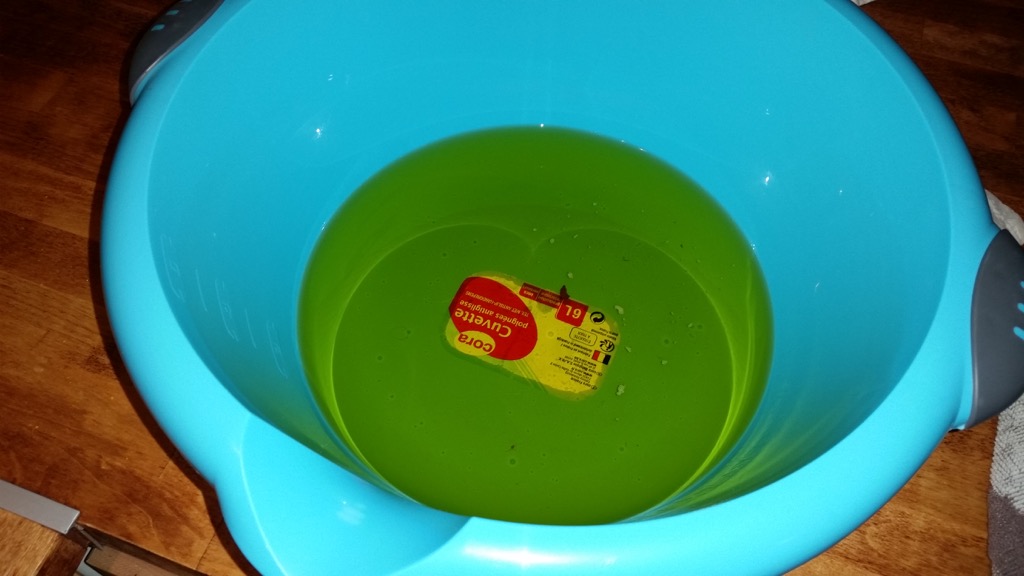 Dump the oils, mixed. The coconut oil was melted before.
Dump the oils, mixed. The coconut oil was melted before.
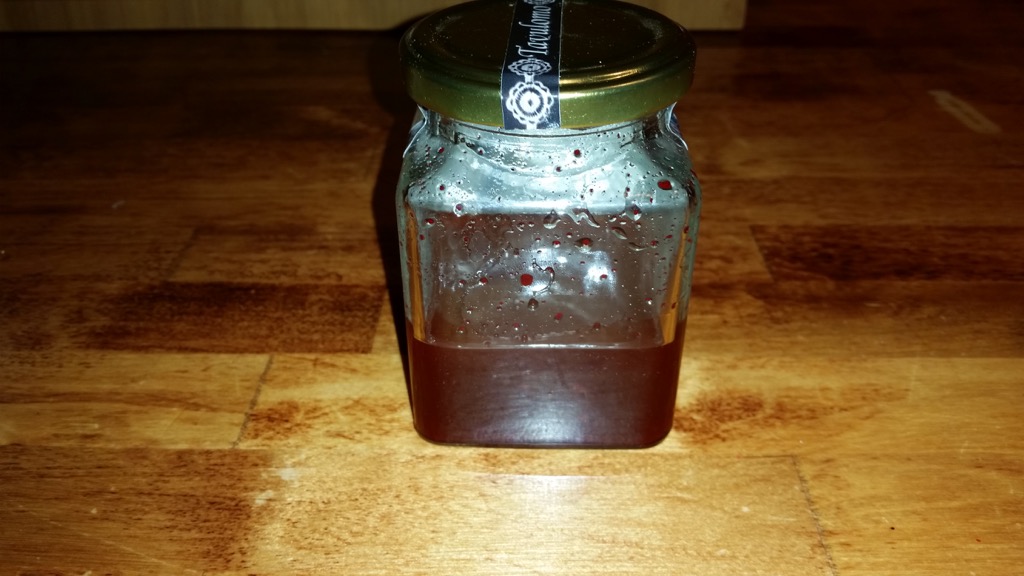 Before mixing the oil with the lye, I mixed a bit of olive oil with the colorant
and the scent. I went for cinnamon oil in this case, which is one of the most
expensive elements of the whole thing.
Before mixing the oil with the lye, I mixed a bit of olive oil with the colorant
and the scent. I went for cinnamon oil in this case, which is one of the most
expensive elements of the whole thing.
 Not pictured, I mixed the caustic soda with the water. The soda over the water,
always! The reaction is quite exothermic (I could feel the heat through the
recipient), so if you do it the other way around you will run into trouble.
Also recommended, do it either outdoors, or under the extractor fan, because
there will be some fumes.
Not pictured, I mixed the caustic soda with the water. The soda over the water,
always! The reaction is quite exothermic (I could feel the heat through the
recipient), so if you do it the other way around you will run into trouble.
Also recommended, do it either outdoors, or under the extractor fan, because
there will be some fumes.
After making the lye, I let it cool for a while, and then pour over the oil slowly, while mixing. After everything is poured, keep mixing. And mixing. Somewhere I had read that the first times is good to do the mix manually, as to see the mix thickens. Nonsense. It takes forever. Use a blender.
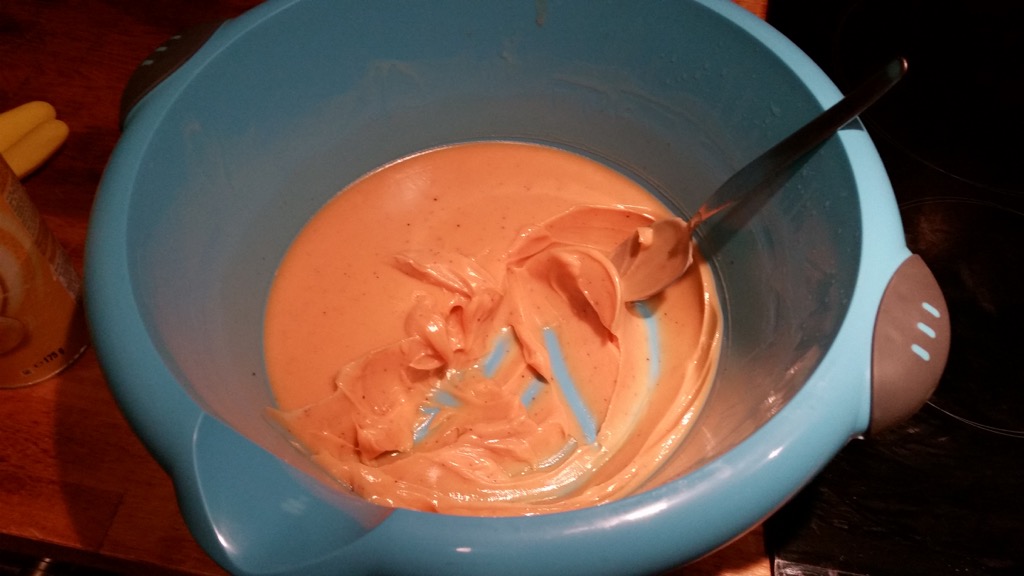 I had to leave before the mix was properly thickened (had proper trace),
but luckily when I came back it had the consistency of very soft butter, so the
saponification was going on!
I had to leave before the mix was properly thickened (had proper trace),
but luckily when I came back it had the consistency of very soft butter, so the
saponification was going on!
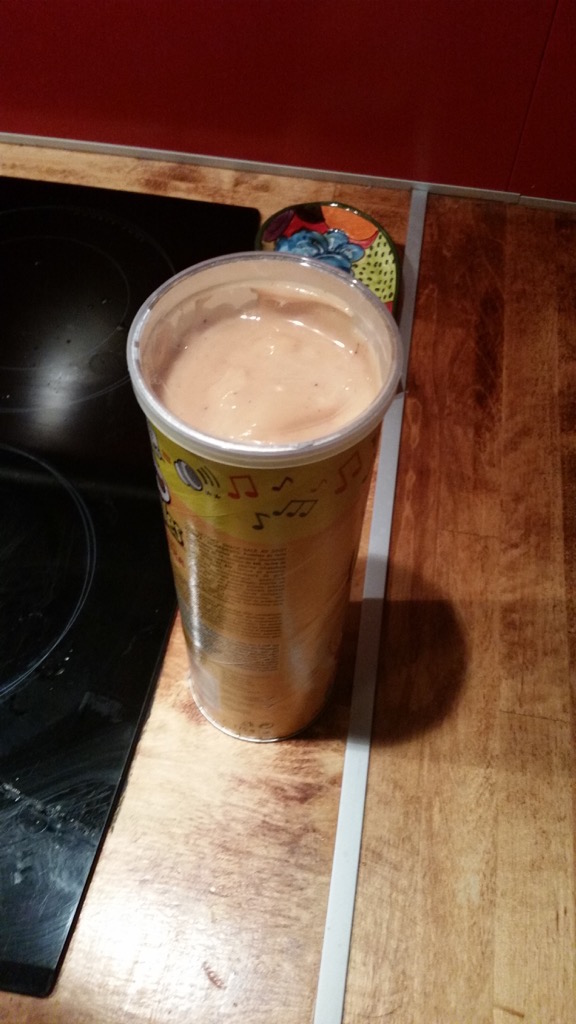 With a spoon I put the mix into the container of a famous brand of chips,
and let it rest.
With a spoon I put the mix into the container of a famous brand of chips,
and let it rest.
 Unfortunately, the soap hadn’t hardened much after 24 hours, nor 48, nor even
three days, where the consistency was buttery. I had to unmold, because I was
leaving for Christmas. The soap was partially stuck to the mold, but at the
end I managed to remove it, and cut.
Unfortunately, the soap hadn’t hardened much after 24 hours, nor 48, nor even
three days, where the consistency was buttery. I had to unmold, because I was
leaving for Christmas. The soap was partially stuck to the mold, but at the
end I managed to remove it, and cut.
I worried it wouldn’t end ok.
 But it did. After four weeks, it hardened reasonably well. It is not as hard
as the soap bars you may get on the supermarket. It is slightly soft,
but not much, and can be used. In fact, I have used it, and it cleans the hands
perfectly fine. The smell is OK too, if a bit on the sweet side.
But it did. After four weeks, it hardened reasonably well. It is not as hard
as the soap bars you may get on the supermarket. It is slightly soft,
but not much, and can be used. In fact, I have used it, and it cleans the hands
perfectly fine. The smell is OK too, if a bit on the sweet side.
I worry I did put more than 5% extra fat (due to some miscalculations), and, in retrospect, I should have probably aimed for less anyway. Given it is made of used oil, I am not going to use it for showering.
For the next time I make soap with used oil, I will try to superfat the soap less, and use a more lemoney scent, so I can use it in the kitchen. And, definitely, I will use a blender.
We’ll see. In any case, it has been fun, and not that difficult. If you are considering it, just go for it. The only thing I would say is: be cautious with the caustic soda.